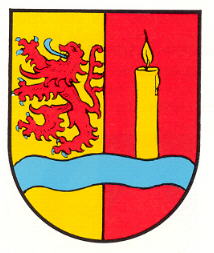Dierbach: Difference between revisions
Jump to navigation
Jump to search
Knorrepoes (talk | contribs) m (Text replace - "|width="15%"|50 px|right |}" to "|width="15%"|50 px|right |}<seo title="Wappen, Gemeindewappen" />") |
Knorrepoes (talk | contribs) m (Text replace - "[[Literature" to "{{media}} [[Literature") |
||
| Line 19: | Line 19: | ||
The lion is taken from the arms of the Counts of [[Zweibrücken]], as the region historically was ruled by the counts. The village was since 1219 obliged to provide the so-called Kaisergruft in Speyer with candles, which is symbolised in the left part of the arms. The wavy bar symbolises the –Bach part of the name, Bach meaning stream or brook. | The lion is taken from the arms of the Counts of [[Zweibrücken]], as the region historically was ruled by the counts. The village was since 1219 obliged to provide the so-called Kaisergruft in Speyer with candles, which is symbolised in the left part of the arms. The wavy bar symbolises the –Bach part of the name, Bach meaning stream or brook. | ||
{{media}} | |||
[[Literature]] : Debus, 1988 | [[Literature]] : Debus, 1988 | ||
Revision as of 20:34, 8 July 2014
| Heraldry of the World Civic heraldry of Germany - Deutsche Wappen (Gemeindewappen/Kreiswappen) |
DIERBACH
State : Rheinland-Pfalz
District (Kreis) : Südliche Weinstrasse
Verbandsgemeinde: Bad Bergzabern
Origin/meaning
The arms were granted on March 9, 1950.
The lion is taken from the arms of the Counts of Zweibrücken, as the region historically was ruled by the counts. The village was since 1219 obliged to provide the so-called Kaisergruft in Speyer with candles, which is symbolised in the left part of the arms. The wavy bar symbolises the –Bach part of the name, Bach meaning stream or brook.
Contact and Support
Partners:
Your logo here ?
Contact us
© since 1995, Heraldry of the World, Ralf Hartemink 
Index of the site
Literature : Debus, 1988











